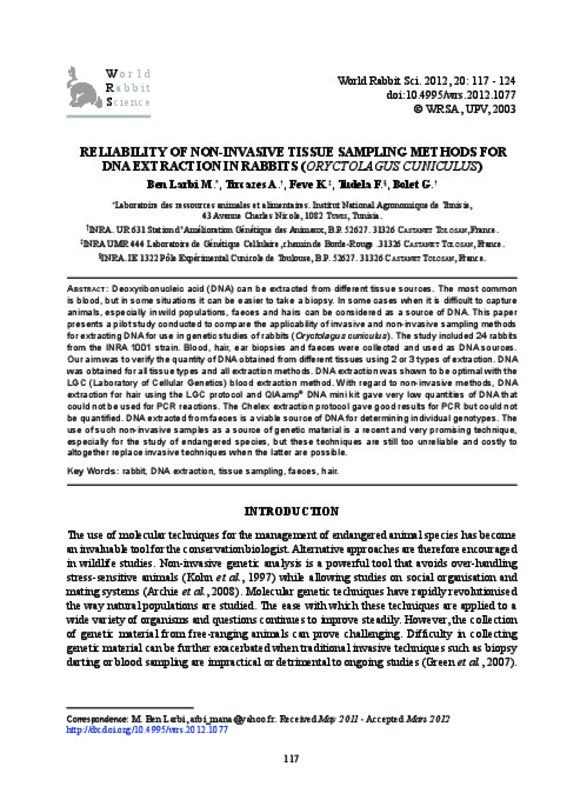JavaScript is disabled for your browser. Some features of this site may not work without it.
Buscar en RiuNet
Listar
Mi cuenta
Estadísticas
Ayuda RiuNet
Admin. UPV
Reliability of non-invasive tissue sampling methods for DNA extraction in rabbits (Oryctolagus cuniculus)
Mostrar el registro sencillo del ítem
Ficheros en el ítem
| dc.contributor.author | Ben Larbi, Manel
|
es_ES |
| dc.contributor.author | Tircazes, A.
|
es_ES |
| dc.contributor.author | Feve, K.
|
es_ES |
| dc.contributor.author | Tudela, F.
|
es_ES |
| dc.contributor.author | Bolet, G.
|
|
| dc.date.accessioned | 2012-07-19T07:48:15Z | |
| dc.date.issued | 2012-06-30 | |
| dc.identifier.issn | 1257-5011 | |
| dc.identifier.uri | http://hdl.handle.net/10251/16717 | |
| dc.description.abstract | [EN] Deoxyribonucleic acid (DNA) can be extracted from different tissue sources. The most common is blood, but in some situations it can be easier to take a biopsy. In some cases when it is difficult to capture animals, especially in wild populations, faeces and hairs can be considered as a source of DNA. This paper presents a pilot study conducted to compare the applicability of invasive and non-invasive sampling methods for extracting DNA for use in genetic studies of rabbits (Oryctolagus cuniculus). The study included 24 rabbits from the INRA 1001 strain. Blood, hair, ear biopsies and faeces were collected and used as DNA sources. Our aim was to verify the quantity of DNA obtained from different tissues using two or three types of extraction. DNA was obtained for all tissue types and all extraction methods. DNA extraction was shown to be optimal with the LGC (Laboratory of Cellular Genetics) blood extraction method. With regard to non-invasive methods, DNA extraction for hair using the LGC protocol and QIAamp¿ DNA mini kit gave very low quantities of DNA that could not be used for PCR reactions. The Chelex extraction protocol gave good results for PCR but could not be quantified. DNA extracted from faeces is a viable source of DNA for determining individual genotypes. The use of such non-invasive samples as a source of genetic material is a recent and very promising technique, especially for the study of endangered species, but these techniques are still too unreliable and costly to altogether replace invasive techniques when the latter are possible. | es_ES |
| dc.language | Inglés | es_ES |
| dc.publisher | Editorial Universitat Politècnica de València | es_ES |
| dc.relation.ispartof | World Rabbit Science | |
| dc.rights | Reserva de todos los derechos | es_ES |
| dc.subject | Rabbit | es_ES |
| dc.subject | Dna extraction | es_ES |
| dc.subject | Tissue sampling | es_ES |
| dc.subject | Faeces | es_ES |
| dc.subject | Hair | es_ES |
| dc.title | Reliability of non-invasive tissue sampling methods for DNA extraction in rabbits (Oryctolagus cuniculus) | es_ES |
| dc.type | Artículo | es_ES |
| dc.date.updated | 2012-07-19T06:40:58Z | |
| dc.identifier.doi | 10.4995/wrs.2012.1077 | |
| dc.rights.accessRights | Abierto | es_ES |
| dc.description.bibliographicCitation | Ben Larbi, M.; Tircazes, A.; Feve, K.; Tudela, F.; Bolet, G. (2012). Reliability of non-invasive tissue sampling methods for DNA extraction in rabbits (Oryctolagus cuniculus). World Rabbit Science. 20(2):117-124. https://doi.org/10.4995/wrs.2012.1077 | es_ES |
| dc.description.accrualMethod | SWORD | es_ES |
| dc.relation.publisherversion | https://doi.org/10.4995/wrs.2012.1077 | |
| dc.description.upvformatpinicio | 117 | |
| dc.description.upvformatpfin | 124 | |
| dc.description.volume | 20 | |
| dc.description.issue | 2 | |
| dc.identifier.eissn | 1989-8886 |








